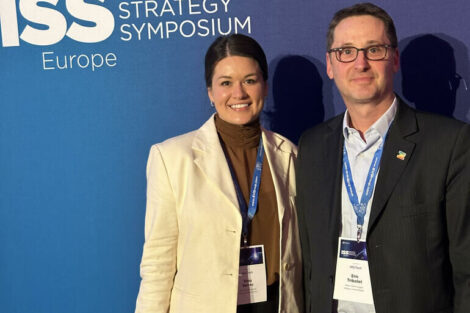Armin Rahn, rahn-tec, Montreal, Canada; Rolf Diehm, Seho, Kreuzwertheim Is it not normal to expect that a manager or a technician feels stressed or even overtaxed by the RoHS (Reduction of Hazardous Substances) laws? Their world has changed because of this directive and those local laws that are its consequence. Processes, equipment and materials must all be re-assessed and separately judged. There are additional questions such as those for a new design and whether it is feasible, whether some of the components that do not adhere to the directive may remain in store – or must remain there for special reasons. It may cross their mind that choices that must be made may infringe on one or even several patents in one or the other marketing region.
Add to this WEEE (Waste of Electrical and Electronic Equipment) and their graying hair may actually start to fall out. Whereas 21 countries of the EU have transferred the RoHS guideline into national law, six nations are limping behind with the WEEE-demanded reclamation system, and the United Kingdom has struggled so hard that they now have decided to move the day of effectivness into the future by some months. The producer may also find certain local peculiarities quite noteworthy: Spain, for example, requires that companies register in each of 17 regions separately. Other countries may come up with their own version of bureaucratic mischief.
Since the WEEE is based on article 175 of the Treaty of Rome (1957), it is a minimal requirement that every state of the EU may embellish at will (?). Companies may therefore deal with 25 laws rather than one. Luckily, the Brussels legislators have based the RoHS piece on article 95 of the Treaty of Rome, and thus have limited the actions of the individual parliaments. RoHS must be introduced without change with all EU members – with potential changes and corrections and additions in the future stemming, however, from Brussels directly.
Waiting for a number of explanations
This is the situation in the EU – But we are still waiting for a number of explanations. The British advisory body has, in the meantime, recommended three amendments and five new exemptions to the original list. Another twenty applications for exemptions await recommendation from this body as the suggestions for change say. Item 7 points 1, 2 and 3 of the Annex are replaced by:
- Lead in high melting point solders (i.e. lead based solders containing 85% by weight or more lead)
- Lead in solders for servers, storage-array systems, network-infrastructure equipment for switching, signaling, transmission as well as network management for telecommunications
Item 8 is replaced by:
Cadmium and its compounds in electrical contacts and cadmium plating except for applications are banned under Directive 91/338/EEC (1) amending Directive 76/769/EEC (2) relating to restrictions on the marketing and use of certain dangerous substances and preparations.
New applications for exemptions are:
- Lead used in compliant pin-connector systems
- Lead as a coating material for the thermal-conduction module C-ring
- Lead and cadmium in optical and filter glass
- Lead in solders consisting of more than two elements for the connection between the pins and the package of microprocessors with a lead content of more than 80% and less than 85% by weight
- Lead in solders to complete a viable electrical connection between semiconductor die and carrier within integrated circuit flip-chip packages
- Two applications have been rejected:
- Optical transceivers for industrial applications
- Safety equipment for fire and rescue services
The stone has started to roll and environmental laws and laws similar to the RoHS restricting the use of materials in the electronics industry sprout like mushrooms after a warm rain. Take the USA for example. There, a federal law that would cover all states is still not forthcoming (the congress discussed the situation of electronic waste recently and intends to continue a discussion on this subject soon). Companies may see this prima face as a good thing. However, 27 states have decided that if Washington is dragging its feet, they can start their own legislation. According to a latest count there are about 100 laws in the making that relate to electronic products. Some want to introduce monetary levies, and others concern themselves with marking and identification, and some address the question of material restrictions.
Then we have the People’s Republic of China (name of the proposed law “Management Methods for Pollution Prevention and Control in the Production of Electronic Information Products”). Japan and Canada are on the short list of countries that plan to introduce environmental laws governing electronic products. They do have to be different in some way in order to show that such efforts are of their own making. Some divergence is minor (marking requirements), others do involve details such as restricted substances or limiting values.
Biggest headache industry has ever seen
Paul Tallentire, president of Newark’s InOne agency, views all this in rather grey shades: “This is the biggest headache the industry has ever seen. I can’t think of another legislative or environmental driver that has had so much impact. This may only be the start of it. We may have just entered a decades-long period where the chemical makeup of our components will be a big part of how we do business”.
Painting the situation black in black may be seen as an effort to promote InOne’s services. On the other hand, we may be inclined to accept them as more or less correct, especially when we read what Jan Pape, no less than marketing director of Texas Instrument’s standard linear and logic products group, has to say on this topic: “We’re seeing more and more discontinuation notices on old products. It just costs too much to convert”. Everyone in this industry can understand the ripple effects of such a discontinuation notice when we face the situation that essential components for products suddenly disappears from the market. Abacus, a distribution center in Great Britain, has announced that it has to write off 3.5m pounds of obsolete stock. The components that do not comply with either the RoHS legislation or the lead-free process are becoming worthless overnight. Nobody wants to buy them any longer.
This is an explanation in order to understand that at least the definition for ‘homogeneous material’ has been forthcoming, which explains the established limiting value (maximum concentration of 0.1% by weight for lead, hexavalent chromium and mercury as well as not more than 0.01% by weight for cadmium). With it, we have been put into the position of being able to test for these concentrations. Take for example a normal packaged semiconductor. In most cases, it consists of at least six ‘homogeneous materials’. Each one must contain not more than the prescribed concentration of restricted chemicals.
Stored products will continue to pose a major problem for many companies. It has become particularly awkward to distinguish the different positions. Which components comply with RoHS and which ones do not? Which ones can be used in wave soldering and which ones are able to withstand reflow conditions for SnAgCu or even SnAg or SnCu – besides write-offs some companies have opted to resell and sell back to the supplier or distributor those positions that they do not want to maintain. Their stinginess jeopardizes some other branches of the industry. Instead of sending such goods – mostly unmarked – into non-European countries where they still can be used in lead-bearing operations, they may find their circuitous way into the unsuspecting hands of their colleagues in Europe. Other organizational complications arise from the need to maintain a certain supply of non-RoHS compliant components for the repair of products under warranty.
Inquiry of the component supply chain
The question may be allowed of whether it is possible to find RoHS-compliant components for all products that also satisfy production requirements. This question points to an area of particular frust-value. Occasionally plastic materials may contain lead and cadmium. As this information is not readily available, is the user forced into the expensive testing of all components and PCB? Pricey laboratory methods would put a very high financial burden onto the board assembler.
Isn’t it nice that the legislators have at least clarified what they mean when they talk about ‘put onto the market’? Explanations from the EU detail that a product has to be transferred ‘from the level of the producer with the intention of sale or use in the EU’. Obviously if the product has been sold to the enduser, the situation is clear: the product has been put onto the market. Less clear is a situation where the sale was not (yet) physical but rather merely legal. The product is now legally owned by someone else (the enduser?) but is still in the producer´s warehouse. Simple transfer into the warehouse will certainly not be seen as ‘put onto the market’.
A manufacturer from abroad (non-EU) can simplify his life by transferring the responsibility to the European importer. The directive foresees in these cases that the importer be taken as the ‘producer’ who carries the entire responsibility for product and compliance. Somehow, we cannot help but think of the last button of the trousers still connected to the suspender.
After all this discussion, we tend to forget that many companies still do not know whether their product falls under the legislation or some of its exemptions. Gary Neviso, chairman of the AFDEC RoHS team in the UK, maintains that even such experts as DTI, ERA Technology or AFDEC itself are frequently unable to make a definite decision. A legal ruling of the relevant offices – as a last resort Brussels – may have to be sought in extreme cases. Any pending decision may not reach us, though, before July 1, 2006. Maybe you are of the opinion that all will be over on July 2006. Don´t worry, job security is just around the corner: after WEEE and RoHS you can start getting yourself and your company involved in the noble goals of EuP.
Essential laws in the USA and Canada
US Federal
HR 4076
S 510
HR 425
HR 668
US State
CA (California)
SB20/SB50
AB2901
AB302/2587/263
AB1415
AB1125
SB1180
CO (Colorado)
HB 1256
CT (Connecticut)
HB 6426
SB 785/793
Hg Edu Red Act
FL (Florida)
SB 674
H1065/SB1534
HI (Hawai)
HB 2013
HR 178
SB 29 / 1077
IL (Illinois)
HB 1165/1149
HB2572/SB424
HB2346/SB1720
SB 773
SB 2551
LA (Louisiana)
SCR6 & 53
MA (Massachusetts)
HB 1533
S692/H2482
HB 1949
MD (Maryland)
HB 109
HB 575
HB 83
HB 136
ME (Maine)
PL 661
LD 743 / HP 549
LD 1790
PL 2001
MI (Michigan)
SB 583 / 218
HB 429 / 4156
SB 147 / 158
HB4406&SB1458
HB 4036 / 4058
MN (Minnesota)
SF 905 (Sec 129)
HBA (SB4A)
HB1299
MT (Montana)
SJR15
NC North Carolina)
H 878 & S 970
SB 1030
NE (Nebraska)
NB 301
NH (New Hampshire)
HB 73
HB562/371/LSR 24
NM (New Mexico)
HJM (House Joint Memorial) 58
SJM 9
NV (Nevada)
AB 65
NY (New York)
S890 & A3633
A5302
A6096
A10050-S7621
Chp145 title27
NYC (New York City)
NYC Bill
OH (Ohio)
SB 274 / SB 70
OR (Oregon)
SB 867
HB 2971
HB 3563/SB 740
SB 962
RI (Rhode Island)
HR 5829
SB 234 / 178
HB5783/SB826
SC (South Carolina)
SJR 148
TX (Texas)
SB 1239/HB 2967
VA (Virginia)
HB 2376
HB 1317
VT (Vermont)
HB 343
S 0111 / SB 84
TL10 Cp159 6621
WA (Washington)
HB 2488
HB 1942
Exec. Order 04–01
HB 1002
Canada
AB (Alberta)
AR 94/2004
NS (Nova Scotia)
Sec102 EnvAct
ONT (Ontario)
RA04E0019
Literature
Management Methods for Pollution Prevention and Control in the Production of Electronic Information Products
Rob Spiegel: RoHS – The Biggest Headache the Industry Has Ever Seen. Electronic News, 8/10, 2005
Ed Sperling: Warning – Lead May Be Hazardous to Your Bottom Line. Electronic News, 4/29, 2005
Share:









